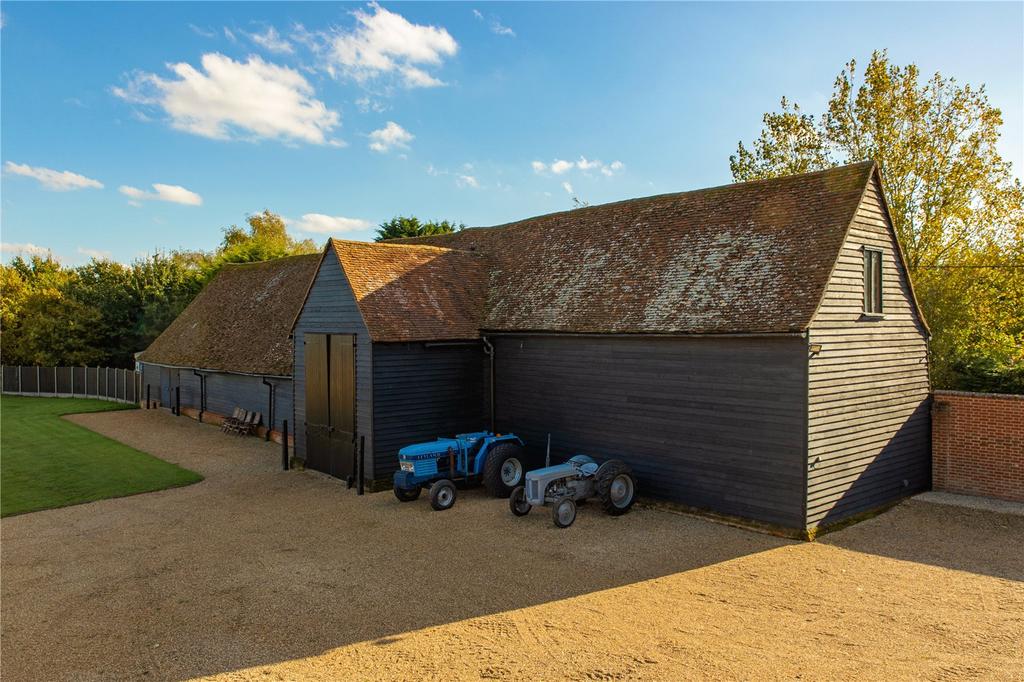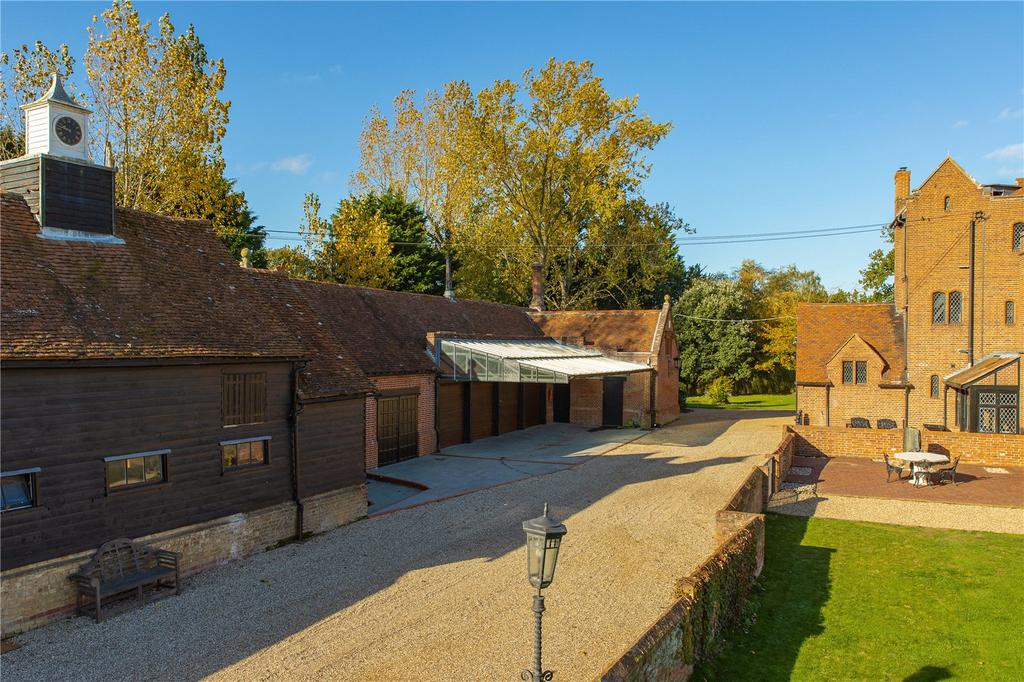No longer on the market
This property is no longer on the market
13 bedroom detached house
Premium display
Under offer
Detached house
13 beds
6 baths
2,001,149 sq ft / 185,913 sq m
Key information
Tenure: Freehold
Council tax: Ask agent
Features and description
- Tenure: Freehold
- Grade II* moated Tudor House
- Magnificent Grade II listed Tithe barn
- Extensive entertaining spaces
- Moated gardens
- 45.94 acres
- EPC Rating = E
A Beautiful Grade II* moated Tudor House
Description
Stanstead Hall is set in about 45 acres of beautiful gardens and paddocks.
Entered via stunning brick pier electric gates. The long driveway meanders to the front of the house through an avenue of trees.
There is ample parking at the front and rear of the house along with garaging for 3 cars.
Outside there are various outbuildings, workshops, gym, large agricultural barn and a stunning listed tithe barn.
There are beautiful gardens and walled garden with heated swimming pool and pool house with bar/pizza oven and terrace.
For accommodation please see floorplan.
Acreage: 45.94 Acres
Additional Info
HISTORY:
An early 16th century house, which is Listed Grade II*, occupies the centre of the island with modern outbuildings situated to the west and south west of it. 25m north of the house are the remains of a chapel. This survives as a flint rubble structure 10m east-west by 7.5m northsouth with walls 1.1m thick and 1.3m high. There are buttresses on each corner. The chapel remains, the 16th century brick tower and the brick wall are included in the scheduling.
The first evidence of a structure on this land dates from the reign of Edward the Confessor when Godwin, Earl of Wessex, inhabited a manor at Stanstead. When William the Conqueror annexed all the land, manors and farms, the estate was given to Robert Malet, who held the office of Chamberlain of England in 1092. He was, however, banished from the realm and his estates seized for his part in the conspiracy to undermine the authority of Henry I. The estate was subsequently awarded to Hubert de Monchensy. The estate passed by marriage to Walter of Colchester in the mid 13th century and again to Sir John Bouchier soon after. In 1340 Sir John Bouchier became Lord High Chancellor of England and was succeeded by his son, Robert, who in 1341 obtained a licence to make his home at Stanstead a castle. It was at this point that the moat was constructed. The manor remained in the hands of the Bouchier family until it passed, by marriage, to Sir William Parr, grandfather of Catherine Parr. Sir William Parr was made Earl of Essex in 1551 and soon afterwards Marquis of Northampton. The marquis lost his lands for supporting Lady Jane Grey. Queen Elizabeth, however, restored Stanstead Hall to him and within three days he had sold the estate to Sir William Waldegrave. The house passed through various hands until it was bought by George Ausrene Esq., Member of Parliament for Stamford in Lincolnshire, who was the owner at the time of the survey taken of Essex and its great houses in 1720. There is little known about the manor from this point until 1907 when it came into the hands of Samuel Courtauld, then, by marriage, to R A Butler, Member of Parliament for Saffron Walden. The house, outbuildings, modern garden walls and driveway are all excluded from the scheduling, though the ground beneath them is included.
Please note, part of the land is subject to farming agreement.
Description
Stanstead Hall is set in about 45 acres of beautiful gardens and paddocks.
Entered via stunning brick pier electric gates. The long driveway meanders to the front of the house through an avenue of trees.
There is ample parking at the front and rear of the house along with garaging for 3 cars.
Outside there are various outbuildings, workshops, gym, large agricultural barn and a stunning listed tithe barn.
There are beautiful gardens and walled garden with heated swimming pool and pool house with bar/pizza oven and terrace.
For accommodation please see floorplan.
Acreage: 45.94 Acres
Additional Info
HISTORY:
An early 16th century house, which is Listed Grade II*, occupies the centre of the island with modern outbuildings situated to the west and south west of it. 25m north of the house are the remains of a chapel. This survives as a flint rubble structure 10m east-west by 7.5m northsouth with walls 1.1m thick and 1.3m high. There are buttresses on each corner. The chapel remains, the 16th century brick tower and the brick wall are included in the scheduling.
The first evidence of a structure on this land dates from the reign of Edward the Confessor when Godwin, Earl of Wessex, inhabited a manor at Stanstead. When William the Conqueror annexed all the land, manors and farms, the estate was given to Robert Malet, who held the office of Chamberlain of England in 1092. He was, however, banished from the realm and his estates seized for his part in the conspiracy to undermine the authority of Henry I. The estate was subsequently awarded to Hubert de Monchensy. The estate passed by marriage to Walter of Colchester in the mid 13th century and again to Sir John Bouchier soon after. In 1340 Sir John Bouchier became Lord High Chancellor of England and was succeeded by his son, Robert, who in 1341 obtained a licence to make his home at Stanstead a castle. It was at this point that the moat was constructed. The manor remained in the hands of the Bouchier family until it passed, by marriage, to Sir William Parr, grandfather of Catherine Parr. Sir William Parr was made Earl of Essex in 1551 and soon afterwards Marquis of Northampton. The marquis lost his lands for supporting Lady Jane Grey. Queen Elizabeth, however, restored Stanstead Hall to him and within three days he had sold the estate to Sir William Waldegrave. The house passed through various hands until it was bought by George Ausrene Esq., Member of Parliament for Stamford in Lincolnshire, who was the owner at the time of the survey taken of Essex and its great houses in 1720. There is little known about the manor from this point until 1907 when it came into the hands of Samuel Courtauld, then, by marriage, to R A Butler, Member of Parliament for Saffron Walden. The house, outbuildings, modern garden walls and driveway are all excluded from the scheduling, though the ground beneath them is included.
Please note, part of the land is subject to farming agreement.
About this agent

Savills - Country Houses





















